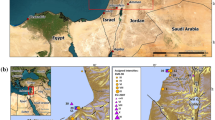Abstract
Results of investigation of the lithosphere in the Kamchatka seismic focal zone from dynamic characteristics of earthquake records obtained at regional stations are presented. It is assumed that the specificity of the source zone can be estimated by the relation Cr = K P − bK S − c characterizing relative energies (energy classes, according to [Fedotov, 1972]) of short period transverse and longitudinal waves in the source. Azimuthal, spatial, and temporal variations in Cr and their relation to focal mechanisms are examined. Spatiotemporal variations in this parameter are shown to be caused by the influence of variations in the conditions in the source zone (its substance or process) on the radiation of P and S waves.
Similar content being viewed by others
References
S. A. Boldyrev, “The Effect of the Lithospheric Structure and Properties on the Seismic Field of the Kamchatka Region,” Fiz. Zemli, No. 6, 5–28 (2002) [Izvestiya, Phys. Solid Earth 38, 447–468 (2002)].
S. A. Boldyrev, “Seismic Heterogeneity and Seismic Anisotropy of the Lithosphere of the Seismic Focal Zone in the Kamchatka Region,” Fiz. Zemli, NO. 1, 19–35 (2005) [Izvestiya, Phys. Solid Earth 41, 17–33 (2005)].
A. M. Dziewonski, T. Chou, and J. S. Woodhouse, “Determination of Earthquake Source Parameters from Waveform Data for Studies of Global and Regional Seismicity,” J. Geophys. Res. 86(B4), 2825–2852 (1981).
S. A. Fedotov, Energy Classification of Kurile-Kamchatka Earthquakes and the Problem of Magnitudes (Nauka, Moscow, 1972) [in Russian].
A. N. Kaverina and A. G. Prozorov, “Variations in the Creepex as a Function of the Tectonic Structural Type and Focal Mechanism: A Statistical Analysis,” in Geodynamics and Earthquake Prediction, Vol. 26 of Computational Seismology (Nauka, Moscow, 1994), pp. 85–93 [in Russian].
G. F. Panza and A. G. Prozorov, “Extension of the Creepex Definition to Magnitudes of Weak Earthquakes: The Italian Region,” in Geodynamics and Earthquake Prediction, Vol. 26 of Computational Seismology (Nauka, Moscow, 1994), pp. 78–84 [in Russian].
O. V. Potapova and S. A. Fedotov, “Parameter Θ = logE S/logE P from Data on Kamchatka Earthquakes,” in Seismicity, Seismic Prediction, and Upper Mantle Properties: Implications for the Kamchatka Volcanism (Nauka, Novosibirsk, 1974), pp. 133–140 [in Russian].
A. G. Prozorov and D. Hadson, “Relation between M LH and m PV as a Function of Regional Conditions and Local Features,” in Magnitude and Energy Classification of Earthquakes (IFZ AN SSSR, Moscow, 1974), Vol. 2, pp. 208–216 [in Russian].
Author information
Authors and Affiliations
Additional information
Original Russian Text © S.A. Boldyrev, V.I. Levina, 2008, published in Fizika Zemli, 2008, No. 3, pp. 40–57.
Rights and permissions
About this article
Cite this article
Boldyrev, S.A., Levina, V.I. Creepex of Kamchatka shallow earthquakes. Izv., Phys. Solid Earth 44, 209–225 (2008). https://doi.org/10.1134/S106935130803004X
Received:
Published:
Issue Date:
DOI: https://doi.org/10.1134/S106935130803004X




